Basil is one of the most popular culinary herbs available. Not only does it fly off the grocery shelves, but it is an easy herb to grow. Since basil is beginner-friendly, many people start their gardening journey with some starts. However, despite its easygoing nature, basil is susceptible to occasional problems. Whether you are a new or experienced gardener, finding out why your plants keep dying can be challenging. We wanted to help you keep your basil plants alive so you can get the largest harvest out of them. So below, you will find the ten most likely reasons your basil plant keeps dying to help you troubleshoot any issues.
1. Disease
Like all plants, disease can strike your basil plant at unfortunate times, reducing your harvest or even killing the plant. Keep a close eye on it to take action as soon as signs of disease show up. Some of the most common ones include root rot, gray mold, fusarium wilt, and bacterial leaf spots. As long as you catch the problems early enough, you may be able to cut away the damaged sections and save the plant. However, if the disease has the opportunity to spread, you could lose the entire plant.
As soon as you see signs of disease, take appropriate measures to treat or cut the impacted areas completely.
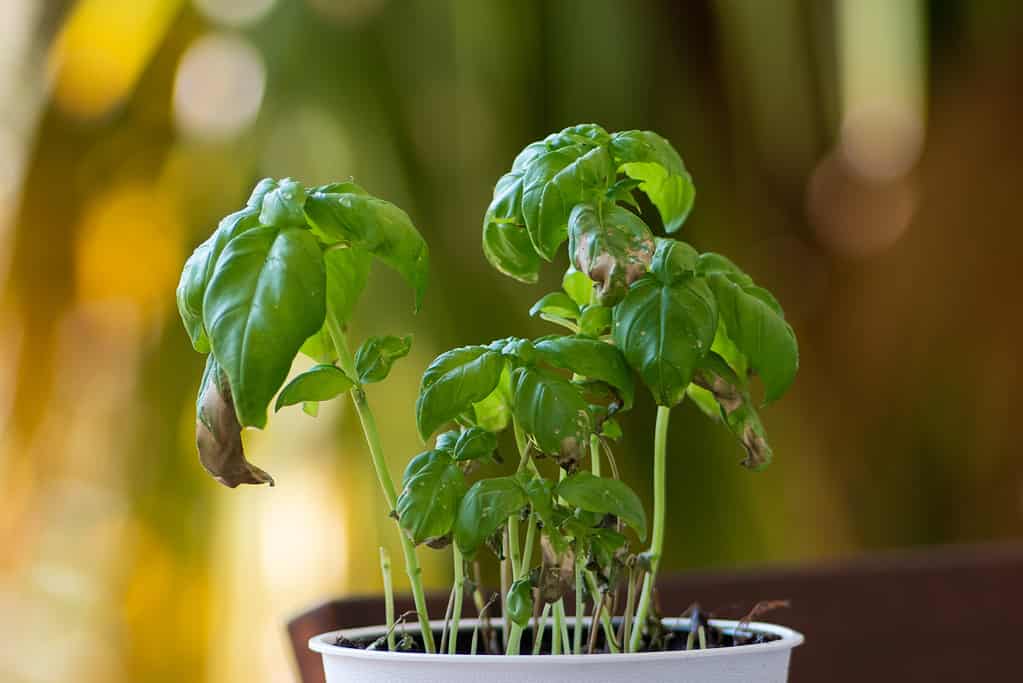
Diseases that strike your basil plants can kill them if it is left unaddressed.
©Octavian Lazar/ via Getty Images
2. Too Much Pruning
Basil plants offer an abundant amount of delicious leaves every growing season. And much of the advice out there is to prune heavily. Unfortunately, you can prune too heavily, which doesn’t leave enough leaves to capture needed sunlight for further growth. Only prune a third of the plant at a time. You can revisit each plant once every two to three weeks for additional leaves. Use sharp shears and prune just above a leaf set.
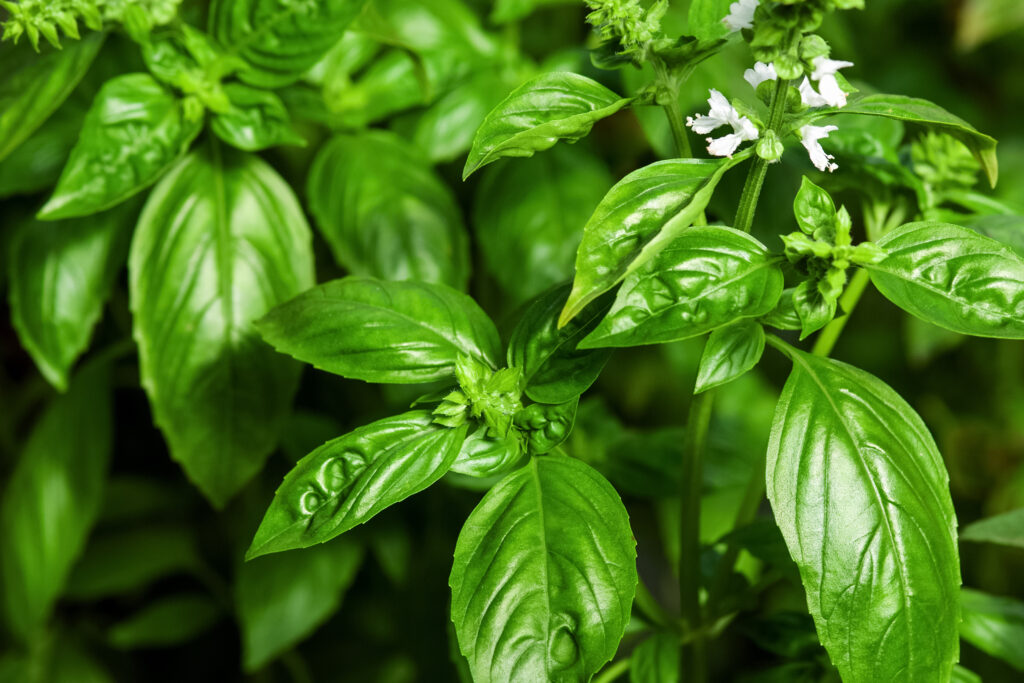
Only prune one third of your basil plant at a time to ensure it has enough leaves for continued growth.
©Nadya So/Shutterstock.com
3. Wrong Temperature
Much like Goldilocks, basil likes its environment just right. This herb thrives in temperatures ranging between 80 to 90 degrees Fahrenheit (26 to 32 degrees Celsius). As the weather begins falling below that temperature range, the basil plant will experience slowed or stunted growth. And if the weather drops too far into the chilly range, this warm-season herb will die.
Likewise, temperatures above this range can result in scorched leaves and a lack of soil moisture. This combination may quickly kill your plants.

Basil thrives in temperatures ranging between 80 to 90 degrees Fahrenheit (26 to 32 degrees Celsius).
©leolintang/Shutterstock.com
4. Excessive Humidity
Basil can tolerate a decent amount of humid weather, which is nice for those growing it in regions like the southeastern United States. However, periods of prolonged or excessively high humidity can cause problems. The trouble isn’t the moisture itself. Rather, if your basil plants get planted too closely together so air cannot properly circulate, it will invite diseases. Ultimately, your plant may die if a disease sets in due to high humidity.

Periods of prolonged or excessively high humidity can cause problems to your basil.
©Markus Schweiss, CC BY-SA 3.0 https://creativecommons.org/licenses/by-sa/3.0/ – Original / License
5. Improper Watering
Watering your basil regularly is critically important. Unfortunately, many of us tackle that task with gusto. And that means we may end up accidentally overwatering our beloved basil. Like many herbs, basil does not like an overly soggy environment. Watering too frequently without giving your plant a chance to soak up the moisture may result in root rot and cause your plant to die. Don’t be fooled by dry topsoil. Stick your finger roughly an inch into the soil. If it is dry at that point, go ahead and water.
Alternatively, underwatering can also result in a dead basil plant. This problem is common during periods of intense heat when we don’t realize how quickly the soil is drying out. On top of that, potted basil requires more frequent watering since container soil tends to dry out more quickly.
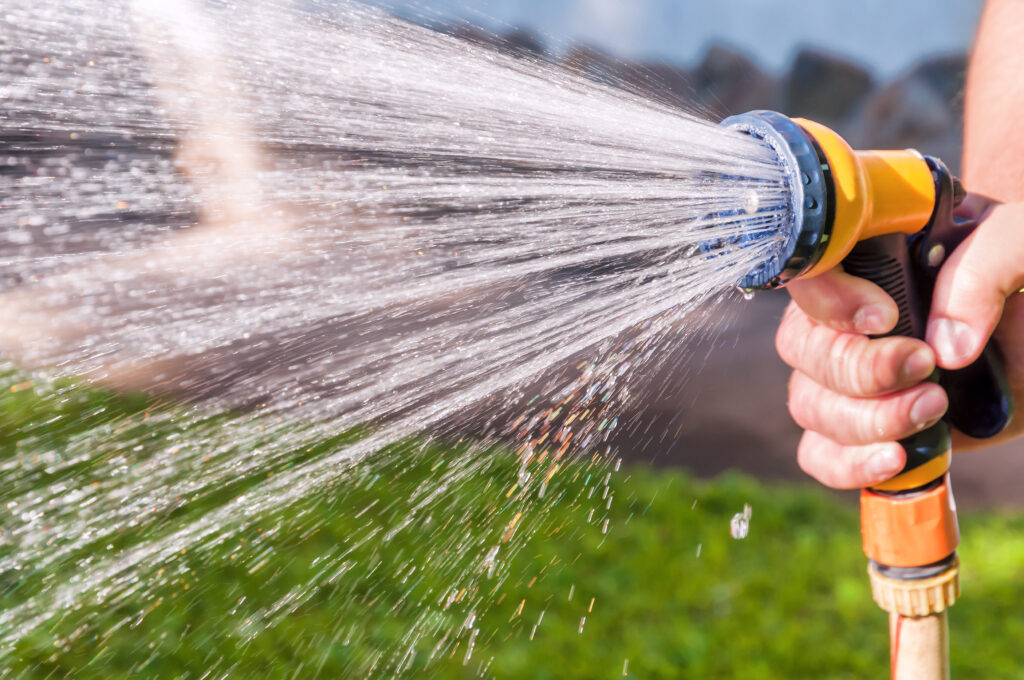
Finding the right balance in watering is vital to ensure your basil plants thrive instead of dying.
©iStock.com/vovashevchuk
6. Soil Fertility Issues
Your basil plant needs fertile soil to thrive and even survive. It grows best in soil that is rich in organic matter. So if your container or garden bed has dead soil or lacks key nutrients, your basil will suffer and may ultimately die. Amend your soil with plenty of compost and other organic matter before planting. Take time to occasionally feed nutrients to help your plant grow if you are growing basil in pots.
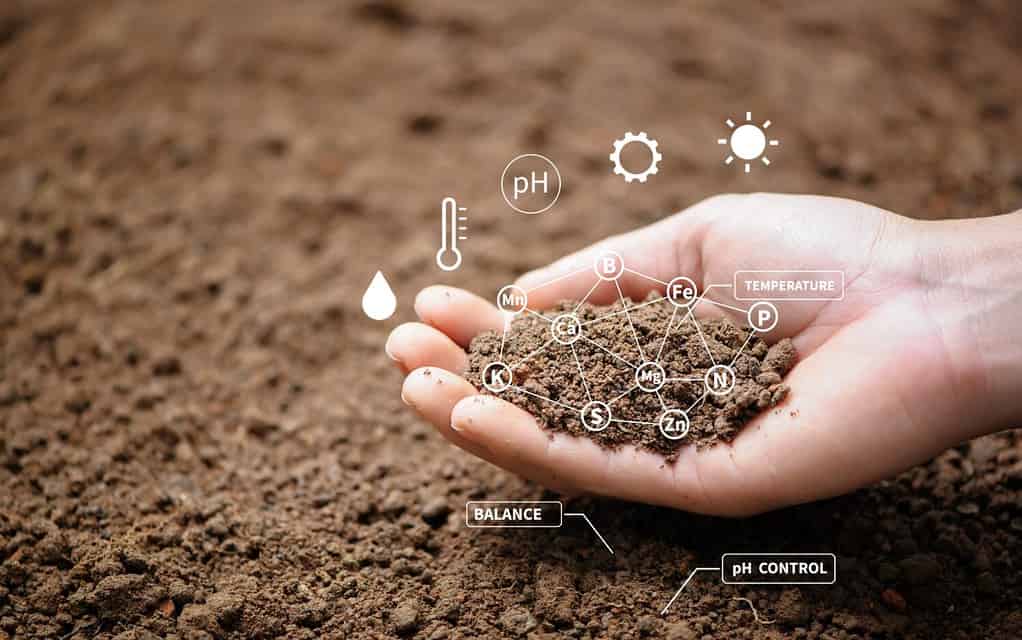
Due to its acidic nature, peat moss isn’t good for every plant.
©Deemerwha studio/Shutterstock.com
7. Too Much Fertilizer
If you read any gardening articles or watch videos about planting on YouTube, you will likely hear the advice to add fertilizer. Oftentimes, this regular reminder may make it seem like you need to add fertilizer more often than you really do. The problem is that too much fertilizer can actually kill your basil plant. Make sure to read the package directions before applying fertilizer to ensure you aren’t over-fertilizing. Remember, sometimes less is more.
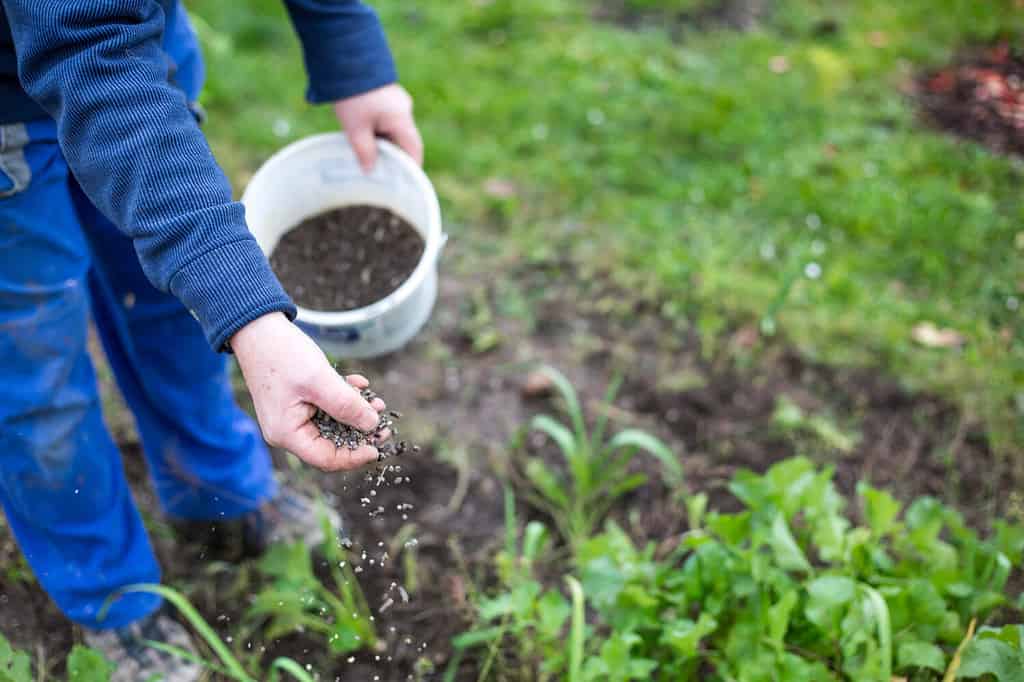
Make sure to read the package directions before applying fertilizer to ensure you aren’t over-fertilizing.
©Simon Kadula/Shutterstock.com
8. Wrong Container Size
Some plants like to be root-bound, but basil is not one of them. Its roots need plenty of room to spread out, which helps them absorb nutrients. Make sure to regularly check the size of the pot you have against where the plant’s roots are. Don’t be shy about potting it up as needed.
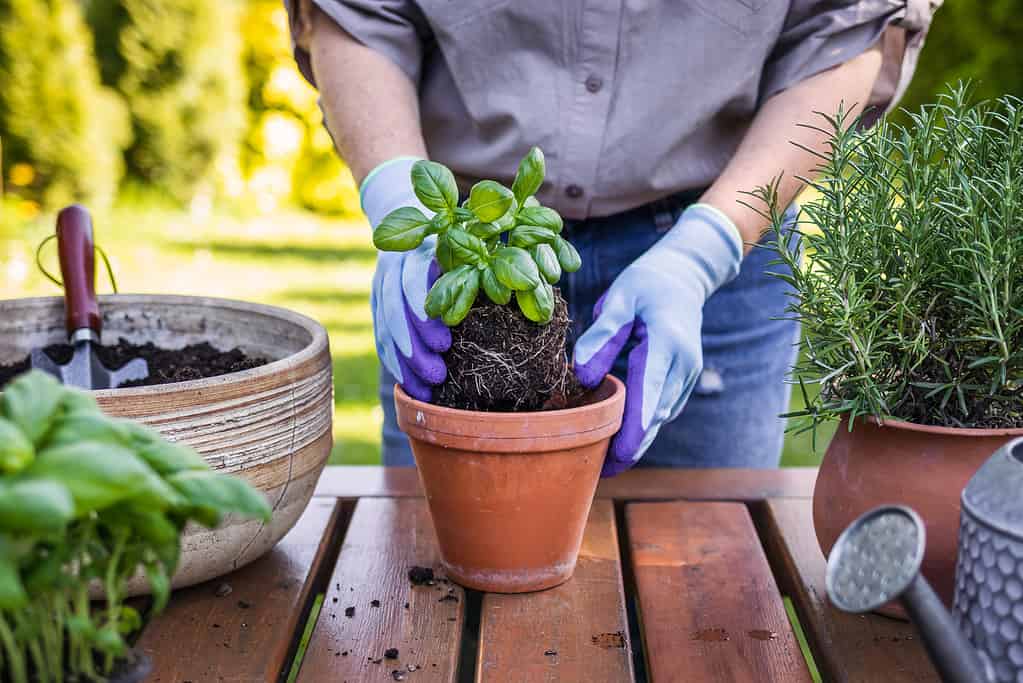
Keep your basil planted in an appropriate size pot to prevent the plant from getting root-bound.
©Zbynek Pospisil/ via Getty Images
9. Not Enough Light
Basil’s rich, flavorful green leaves get that way due to sun (or light) exposure. This herb needs at least six hours of direct sunlight daily to thrive. Anything less than that will force the plant to shift its energy into growing up rather than out. So, your basil plant will grow spindly instead of developing busy green leaves. And since that poor level of growth isn’t sustainable, the plant will die sooner than it should.
Plant your basil in an area that receives adequate sunlight during the day. And if you are growing it inside, don’t worry! A quality grow light works as a decent substitute for natural light. However, there is a caveat. You need to add additional hours of exposure when you use grow lights. So, plan on keeping your basil under the grow light for eight to ten hours daily to keep your basil thriving.
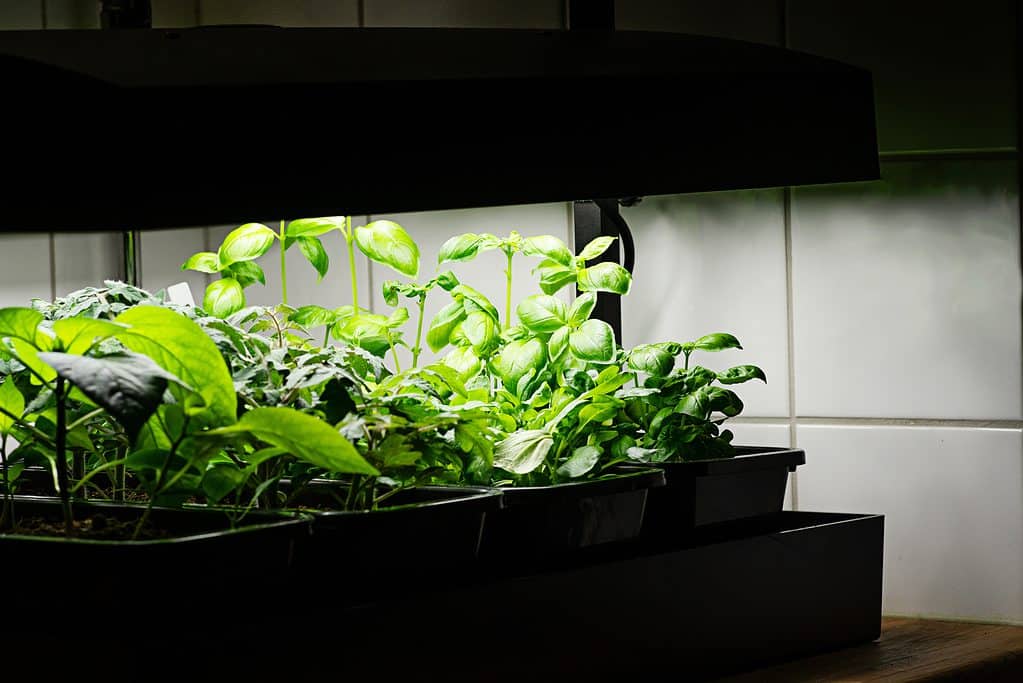
Indoor basil plants require eight to ten hours under a grow light daily. Basil plants that live outside need direct sunlight for at least six hours daily.
©Susie Hedberg/Shutterstock.com
10. Poor Drainage
Since basil is a popular herb to grow in containers, it can face the additional challenge of improper drainage. While basil enjoys consistently moist soil, it does not like to remain waterlogged. If the roots hang out in water too long, they are susceptible to root rot. And, unfortunately, that means your plant will die. So, before planting or transplanting your basil, make sure the pot you selected has appropriately sized drainage holes.
It also bears mentioning that even in-ground gardens can lack adequate drainage. If your soil has a clay composition, it may not offer enough drainage for your basil plants. Consider amending the garden beds to help loosen up the heavy clay.
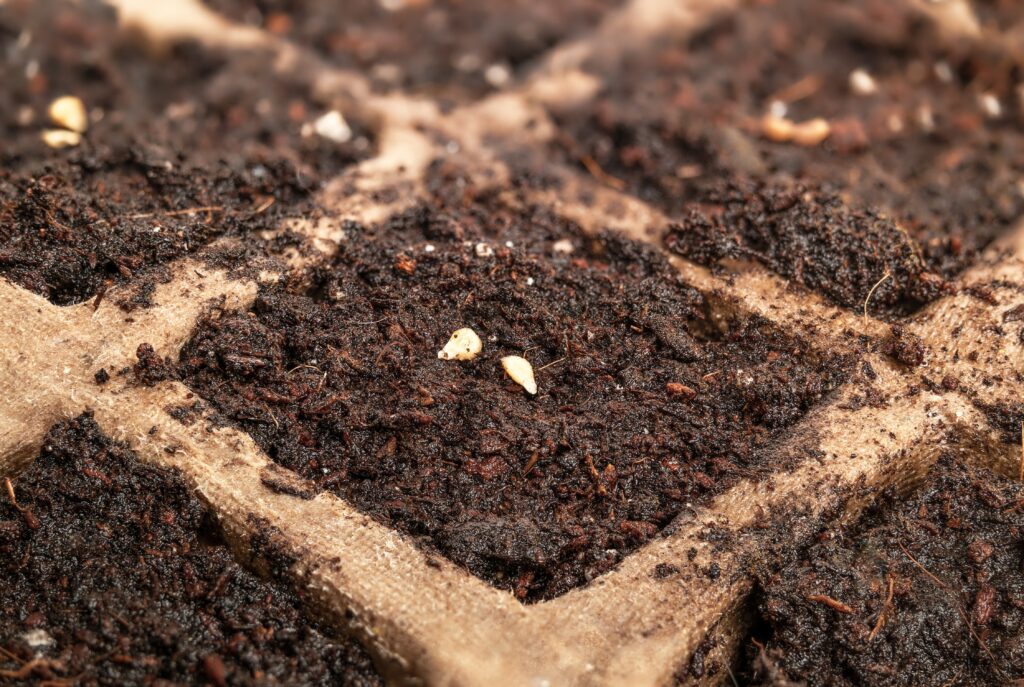
Whether your basil lives in a container or a raised bed, ensure it has proper drainage so the roots don’t get waterlogged.
©sophiecat/Shutterstock.com
Summary of the 10 Most Likely Reasons Your Basil Plant Keeps Dying
| Number | Problem |
|---|---|
| 1 | Disease |
| 2 | Too Much Pruning |
| 3 | Wrong Temperature |
| 4 | Excessive Humidity |
| 5 | Improper Watering |
| 6 | Soil Fertility Issues |
| 7 | Too Much Fertilizer |
| 8 | Wrong Container Size |
| 9 | Not Enough Light |
| 10 | Poor Drainage |
Thank you for reading! Have some feedback for us? Contact the AZ Animals editorial team.








